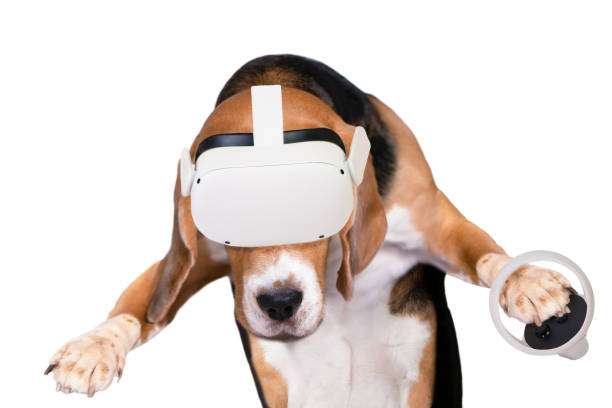
Training Pets with Virtual Reality: The Future of Pet Education
Dive into the groundbreaking potential of virtual reality in pet training. Discover how this innovative tool is transforming the way we teach and communicate with our furry companions.
🐶 Pet Star
22 min read · 31, Jan 2025

The Rise of Virtual Reality in Pet Training
It was a brisk morning when Sarah first heard about virtual reality (VR) for pet training. As a dedicated dog owner, she had tried almost every trick in the book: clicker training, positive reinforcement, and interactive toys. But her energetic Labrador, Max, just couldn’t seem to grasp some commands. A friend casually mentioned a new trend—training pets with virtual reality. Skeptical but intrigued, Sarah decided to look into it. Little did she know, this cutting-edge technology was about to revolutionize her approach to training Max.
The idea of using VR for pet education might sound like science fiction, but it’s slowly becoming a reality in pet care. Virtual reality has long been used in human education and therapy, but its potential in the world of pets is just beginning to be explored. By using VR technology, pet owners can now train their pets in a controlled and immersive environment, replicating real-life situations and challenges. For the first time, training could go beyond the physical space of a dog park or living room, offering pets unique, virtual learning experiences.
How Virtual Reality Works for Pet Training
To understand the potential of VR in pet training, it's important to know how it works. In traditional pet training, you rely on visual cues, verbal commands, and physical rewards. With VR, however, pets interact with a completely virtual world, guided by carefully crafted scenarios designed to teach specific behaviors. For example, a VR scenario might simulate a crowded park environment where your pet must learn how to ignore distractions and focus on you.
But how exactly does VR for pets work? Imagine a dog wearing a special VR headset designed for canines, or an entire environment set up for cats to interact with through a screen. While this may seem outlandish, researchers and innovators are finding ways to use technology to create an immersive world for pets, where they can engage with objects, sounds, and visuals in a safe and controlled space. The goal? To help pets practice behaviors they might not be able to in the real world, like socializing in busy environments or responding to specific cues when distractions are present.
Benefits of Virtual Reality Pet Training
For pet owners, the potential benefits of virtual reality training are exciting. Traditional pet training can often be slow, with progress limited by the pet's ability to focus or the availability of training locations. VR can offer a new level of efficiency, speed, and fun in pet education.
1. Simulated Real-World Scenarios
One of the biggest advantages of VR training is the ability to create real-world scenarios without the risk of harm. For example, if you're training your dog to interact calmly with other dogs, a VR program can simulate dog parks, busy streets, or even crowded events, helping your pet become more accustomed to these environments. This would be especially useful for anxious pets or those who struggle with specific situations.
2. Increased Focus and Engagement
Pets, particularly dogs, often struggle to stay focused in traditional training environments, especially with distractions around them. With VR, pets can focus on the task at hand in a distraction-free virtual environment. For example, a dog might be trained to follow commands in a simulated environment filled with moving objects and other animals, which helps build concentration and improve obedience.
3. Safer, More Controlled Environment
Training in the real world can sometimes present risks—whether it’s a loud noise causing your dog to get scared, another dog becoming aggressive, or an unsafe environment for your pet to explore. With VR, these risks are minimized. Pets can experience new situations and challenges without exposure to danger, ensuring that the learning process remains fun, safe, and effective.
4. Tailored Training Experiences
Just like human education, virtual reality can be customized to fit each pet’s individual needs. Some pets may be more food-driven, while others respond better to praise. With VR, the training program can be adjusted to cater to different pets, offering a personalized approach that is more likely to be effective.
The Future of Pet Training: Where VR Is Heading
Though still in its early stages, the future of VR in pet training is incredibly promising. As technology advances, it's possible that VR will become a mainstream tool for training pets of all kinds. Already, companies are experimenting with creating virtual environments for everything from obedience training to behavior modification for pets with anxiety or aggression issues.
In the future, pets may be able to “attend” virtual training sessions with trainers and owners, interacting with their environment in real time. Dogs could be trained to interact with a virtual ball, respond to simulated commands, or practice being around other pets. The possibilities are endless, and as the technology continues to evolve, it’s likely that VR will become a powerful tool in the pet care industry, providing both convenience and effectiveness for pet owners.
The Challenges Ahead
While the possibilities are vast, there are still several challenges ahead before virtual reality becomes a widely used tool for pet training. One of the main obstacles is the ability to make VR devices suitable for pets. Dogs, cats, and other animals have very different needs compared to humans, meaning VR equipment needs to be carefully tailored to their physiology and behavior.
Additionally, there’s the challenge of making VR training affordable and accessible for pet owners. As of now, most virtual reality systems are expensive, and specialized equipment for pets is still in its infancy. However, with the rapid pace of technological development, it's likely that solutions will be found as the market for VR pet training expands.
Conclusion
The future of pet education is exciting, and virtual reality is at the forefront of this revolution. As pet owners, we’ve always wanted to provide the best for our pets, whether it’s in the form of training, socialization, or mental stimulation. With VR technology, we now have an innovative and effective tool to help pets learn in a safe, controlled, and engaging environment. While the technology is still emerging, it holds incredible promise for both professional trainers and everyday pet owners looking to improve their pet’s behavior. If the experiments in VR pet training are any indication, the future of pet care is not just virtual—it’s limitless.
Q&A: All About Virtual Reality for Pet Training
Q: Can all pets use virtual reality for training?
A: While VR for pets is still in its infancy, it’s primarily designed for dogs and other animals that are trainable with visual and auditory cues. It’s still being tested for broader applications.
Q: Is VR training safe for pets?
A: Yes, VR training is designed to be safe. It’s used in a controlled environment, minimizing risk and ensuring that pets aren’t exposed to any harmful stimuli.
Q: How can I try virtual reality training for my pet?
A: As of now, VR for pets is being developed by a few companies. You can research companies offering virtual training services and inquire about equipment availability. It’s still a niche market.
Q: How long does it take for a pet to learn using VR?
A: The time it takes for a pet to learn through VR depends on the individual pet and the complexity of the training. However, because VR training can be highly focused and tailored, many pets show faster progress than traditional methods.
Q: Will virtual reality replace traditional pet training methods?
A: While VR offers a lot of potential, it’s unlikely to completely replace traditional training. It’s most effective as a supplemental tool, providing a new and exciting way for pets to learn in different environments.
Virtual reality holds incredible promise in revolutionizing pet training. As we continue to embrace this technology, it could lead to a future where pets can learn and adapt in immersive, safe, and engaging virtual environments—ultimately improving the bond between pets and their owners.
Similar Articles
Find more relatable content in similar Articles

Pets and Mental Health: The Science Behind Emotional H..
Discover the profound impact o.. Read More

How Climate Change Affects Wild and Domestic Animals...
Climate change is dramatically.. Read More

The Growing Trend of Therapy and Emotional Support Ani..
Exploring the remarkable rise .. Read More

How Pets Strengthen Family Bonds...
Pets are more than just compan.. Read More
Explore Other Categories
© 2024 Copyrights by rPets. All Rights Reserved.